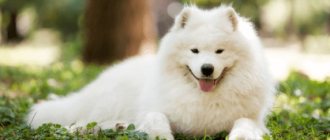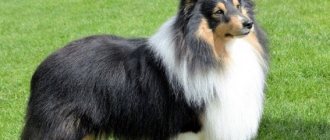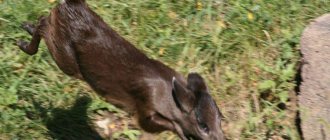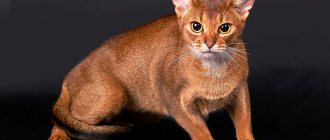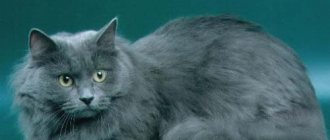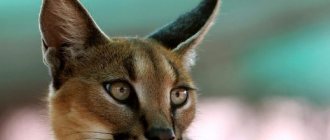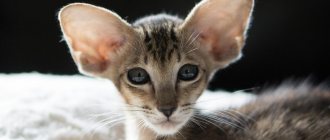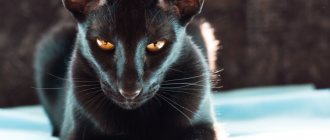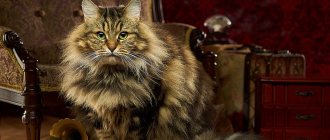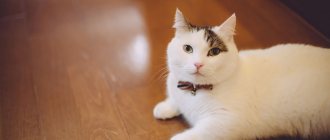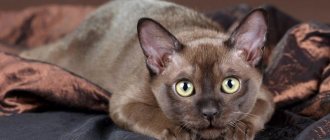Characteristics of an Oriental cat - character and habits
By their nature, Orientals are real stars because they want to be the center of attention. They will not wait peacefully while the owner goes about his business. Instead, the ori will readily jump onto his lap or spin around, demanding immediate attention.
At the same time, they are also extremely sociable - the breed is capable of making a variety of sounds from purring to meowing with different tonality and duration. Therefore, in the absence of proper attention, the furry pet is ready to drive the owner crazy with its demanding talkativeness.
Character
Cats are distinguished by their sociability and playfulness. There is an extensive vocabulary for each occasion, euphonious voices utter hundreds of variations of tones.
Owners share their impressions about the character of Oriental cats; they are not at all bothered by the talkative nature of their pets.
There is also a desire for tactile contact; pets sit blissfully in their arms, while conducting a dialogue with the owner.They don’t like loneliness and are homebodies, but they can sometimes go outside, take a walk and change their surroundings.
They are open to communication and easy to train, love to eat delicious food, professionally beg for more and are able to steal food from the table. There is no need to indulge, obesity leads to heart problems.
They retain playfulness throughout their lives and are a cheerful company for children.
Description of the breed
Like any representative of the species, an Oriental cat must meet a certain breed standard. Compliance with regulations is especially important for owners planning exhibitions and breeding of animals. But even someone who takes an Oriental just as a companion needs to understand what a pet should look like.
Appearance - what an oriental looks like
The head is of medium size and clearly proportional to the body. The shape resembles a wedge with straight lines. The wedge starts from the nose and gradually widens towards the ears. When viewed in profile, a slight convexity of the skull is determined. The forehead is flat. The ears are large, set wide and directed straight, at an angle in relation to the head. They are wide at the base, but the tips become pointed. The eyes are medium in size, almond-shaped and slightly slanted towards the nose. The classic shade is bright green. The nose is long and straight.
The neck is long, with a smooth transition into the line of the back. The body is long, with clearly defined muscles, but graceful. The limbs are slender and proportional to the body. The paws are oval shaped and quite small. The tail is thin and long, tapering towards the tip, reminiscent of a whip.
Today, according to their appearance, Orientals are divided into two types: classic and extreme. Extreme type cats have low-set ears and a very elongated muzzle.
Size
Normal height at the withers for an adult Oriental is considered to be between 23 and 25 cm. The body can be up to 90 cm long.
Weight
The average weight of an adult cat of the Oriental breed ranges from 3.7 to 4.5 kg. The normal weight for a cat ranges from 2.3 to 3.2 cm.
Wool
The breed is short-haired, the hair is fine and shiny. All fur should lie close to the body and be silky to the touch. There is practically no undercoat.
Colors
The classic colors of Oriental cats are:
- Ebony is a black shade of wool, also called black solid.
- Bronze - the shade resembles bronze, but a bright red color is acceptable, closer to red, while the paw pads and nose are soft pink.
- Lavender - this color is also positioned as lilac, the paws and nose are lavender, sometimes their shade is closer to pink.
- Havana is a classic chocolate color, can vary from light to dark brown, paws are brown-pink, nose is brown.
- Blue - a combination of gray-blue with a slight shade of silver, paw pads and nose are blue.
- Cream or fawn - includes fawn (beige coat) and cinnamon (shades of red or very light brown), paws and nose should be pink.
- Tortoiseshell or tri-color - it combines white, black and red wool.
- White is a unique color without a yellow tint, the paws and nose are soft pink, the eyes can be not only green, but also blue, or heterochromia may appear.
In addition, Ories can have a tabby color (the presence of spots, flats, marbled patterns, etc.) on top of the main shade of the coat.
Feeding
Lean cats love to eat, but are not at all worried about their figure. But in vain, the Oriental cat is prone to obesity. The owner’s task is to take care of this figure and provide the kitty with balanced nutrition.
It is very difficult to maintain proper nutrition on natural food, so breeders recommend ready-made dry food and premium canned food.
But if you are a principled opponent of such nutrition, then keep in mind that Orientals need fats for the beauty and shine of their coat. Add a gram of butter to each serving.
The caloric intake per day for cats is up to 300 kcal, for cats – 250 kcal.
Oriental cats can also be given milk, their body copes with it well, but it is important to remember that milk is not the main dish on the menu and it is better to treat your pet with it an hour or two after the main meal.
Experts also note that food for cats of this breed should be comfortably warm and they should be fed in a calm environment so that their excitable nervous system does not interfere with food intake.
Are Oriental cats hypoallergenic or not? How often do they shed?
Orientals can be called practically hypoallergenic, since their protein (which provokes allergies in humans) is synthesized to a lesser extent than in other breeds.
Shedding in eastern cats is moderate, and therefore does not cause any special problems. With proper care of the coat and sufficiently humidified air in the house, shedding will occur only in the autumn and spring seasons. At this time, the owner will need to increase the frequency of brushing the pet to several times a week.
Playfulness
An eared cat with a Georgian nose will happily run after a ball, bring toys to its owner like a dog, and simply play with a new thing. She is active and mobile, loves to explore everything, and there is not a place in the house where she will not climb, informing the owner about it. Sometimes she can purposefully hide and watch as people are looking for her, and then suddenly jump out, inviting her to play. It will be useful for the future owner of an ori to purchase a gaming complex for the pet in order to engage the pet in an activity without your participation.
How to cope with loneliness
Orientals become strongly attached to their owner, and therefore his absence becomes very stressful. Long-term solitude or frequent absence of the owner due to work and other reasons can be a serious test for the pet. As a result, such a “Georgian cat” may not only end up in a state of severe stress, but also begin to get sick as a result of nervous exhaustion.
Health
Generally healthy Oriental cats are predisposed to several diseases:
- gingivitis. This disease is caused by an infection from tartar. Symptoms of the disease are bad breath, the animal’s refusal to eat, and excessive salivation. Prevention is simple – regular cleaning of the animal’s mouth;
- hereditary liver amyloidosis;
- progressive retinal atrophy. This disease can affect an animal at any age, the symptoms go unnoticed, only a special examination by a veterinarian can reveal the disease;
- flat chest syndrome. This disease is typical only for kittens. Such deformation in a weak form gives the kitten a chance of salvation, because as the animal grows, its chest straightens, but a severe form of deformation leads to the death of the animal;
- cardiomyopathy (heart disease).
Forewarned is forearmed. Just keep an eye on your pet and remember to visit the veterinarian periodically.
Orientals also need to be hidden from drafts. They do not have an undercoat and for this reason they frankly freeze in our latitudes. Consequently, they are also not adapted to life on the street.
But in an apartment, and with proper care, the life expectancy of an Oriental cat is 15-17 years.
Oriental catteries
You can purchase an Oriental breed cat from one of the following nurseries:
- Nursery Avatar. Located in the Moscow region, in the city of Vidnoye.
- Salambo nursery. Located in Moscow. The nursery is registered with WCF. They are engaged in breeding Oriental and Siamese cats.
- Nursery JUNGLE. Located in Moscow. The nursery is registered with WCF and FIFe. They are engaged in breeding Oriental, Seychelles and Siamese cats.
- Nursery MASCOT. Located in Moscow. The nursery is registered with FARUS. They breed only oriental cats.
- Liberty World Nursery. Located in Moscow. The nursery is registered with WCF. They breed only oriental cats.
Approximate prices
In Russia, you can buy an Oriental breed kitten for approximately the following amount of money:
- In a nursery or from a professional breeder (an animal with a pedigree, veterinary passport and card) - from 20,000 to 40,000 rubles .
- At the pet market (pet without a pedigree, but with a veterinary passport) - from 10,000 rubles .
- According to an advertisement on the Internet or in a newspaper (a cat without a pedigree and veterinary documents) - from 8,000 rubles .
Need for care
The Siamese Oriental is not a difficult breed to care for. Brushing them once a week is enough, and trimming their nails should be done once a month.
But they should be bathed a couple of times a year. More frequent bathing will be stressful for the pet, and is also not necessary for the cat itself. Ori do a good job of cleaning themselves. Also, on water treatment days, it is important for the owner to use only a special hypoallergenic shampoo.
The eyes of Orientals should be wiped daily using a cotton pad soaked in a light chamomile decoction. In addition, Ori's sensitive ears need to be cleaned with special products according to the veterinarian's recommendations weekly.
Maintenance cost
For a full and long life of an ori, the owner needs to understand not only how to maintain this cat, but also how much financial investment this will require.
Nutrition
The priority type of feeding is the use of dry food, and it is best to choose holistic and premium food. This is due to the sensitivity of Ori's digestion and their tendency to gain weight. The cost of monthly feeding with such food can cost the owner from 4 to 10 thousand rubles.
Feeding with natural products is also allowed, but the owner will have to strictly monitor the balance of the Oriental’s diet. And the price of such food will directly depend on the choice of products and their quality.
Veterinary
Carrying out standard vaccination according to the calendar will cost the owner of the ori in the amount of 1 to 3 thousand rubles. Any other costs are determined by the veterinarian according to their necessity.
Grooming
Caring for Oriental cats does not take much time, but a visit to the groomer can be a pleasant change for the pet and make life easier for the owner. One trip to the salon to the groomer can cost the owner of a fluffy beauty from 2 to 3 thousand rubles.
Exhibitions
Visiting exhibitions can cost from 5 to 30 thousand rubles. for participation in one event in Russia. The price varies according to the status of the exhibition and the title of the winners. But this amount does not include the cost of travel to the venue, accommodation and food for the owner of the oriental and his pet.
Pros and cons of the breed
Of course, the positive qualities of Oriental cats include:
- Exotic and aesthetically pleasing appearance.
- Friendly to people and animals.
- The ability to subtly sense the owner at the level of intuition.
- Highly developed intelligence.
- Ease of learning, up to the possibility of full training of the pet.
- Sociability and affectionate behavior.
- Fairly simple care.
- Lack of an extensive list of genetic pathologies.
- Hypoallergenic.
The disadvantages of the breed include:
- High price.
- Touchiness.
- The need for a lot of attention from the owner.
- Sensitivity of the digestive system.
- Poor tolerance to cold.
Training and education
Walking an oriental cat on a leash
Orientals inherited from their Thai ancestors a lively, sharp mind and excellent learning abilities. In particular, it is easy to “train” a cat to fetch objects, as well as to carry out simple commands. As for the basics of etiquette, their pet will have to be instilled, because, despite the fairly high level of intelligence, oriental cats are capable of minor dirty tricks. For example, little eared cats love to swing on curtains and dig into flower pots. They do this not out of harm, but out of thoughtlessness, so it is very important to immediately point out to the kitten that such behavior is unacceptable.
Punishing, let alone beating, an animal is the last thing. An Oriental cat can easily guess about its own mistakes, relying only on the intonation of your voice, so use this quality to its full potential. Sternly shout at the mustachioed lawless man walking around the table and hiss expressively at the kitten climbing the curtains. You can be sure that the pet will intuitively understand what they want from him.
A common mistake that can negate the results of all your efforts is periodic exceptions to the established rules. As an example: today a serious reprimand has been given to the kitten jumping on the table, and tomorrow you are filming a video for YouTube where the tiny Cheburashka is briskly climbing the tablecloth to your encouraging comments.
History of the breed
Back in the 19th century, the first mentions of Siamese cats with a full solid color appeared, but until 1923 there was debate about whether they should be included in the breed standard. As a result, the British Siamese Club decided that this quality of the breed is not encouraged. From this moment, work began on the selection of future oriental cats. In the process of crossing with Siamese, Russian Blues, British Shorthairs, Abyssinians and even simple domestic cats were brought together.
As a result, in 1956, the American nursery imported the first representative of the oriental breed with a chocolate color. In 1958 they accepted the original form of the general breed standard and continued breeding it. Subsequently, breeders from America were able to achieve recognition of the solid-colored Oriental cat as a separate breed in 1977 and continued to work on creating new colors in the breed.
Already in 1995, bi-color (two-color) cats were able to gain recognition, and the breed began to be popularized around the world.
Interesting Facts
not only interesting in appearance.
Oriental breed cats are interesting in many respects. Here are some fun facts about them:
- popularly called “rainbow” due to the variety of colors;
- Orientals are almost the only representatives of cats who do not have genetic pathologies;
- these are long-livers, since their lifespan can reach 20 years;
- before official registration, Orientals were called “one-color coffee Siamese”;
- oriental cats need constant tactile contact with their owners and active games, otherwise they begin to meow loudly;
- jealous of their owner's attention to other people and even objects;
- Orientals never release their claws, so it is safe to leave children with them;
- cats show devotion, characteristic only of dogs;
- They are popularly called “talkers” due to their inability to remain silent for even a few minutes.
Interesting facts about Oriental cats
It is useful for anyone planning to purchase an Oriental to learn about the interesting features of the breed:
- In the world of Orientals, they are often called rainbow cats. They received this nickname for their rich variety of colors.
- The lack of undercoat becomes a problem for the pet, and therefore in the cold season it is necessary to dress it warmly.
- Before the breed was fully recognized, many cat lovers called Orientals single-colored coffee-colored Siamese.
- Ori are jealous of their belongings and the place they choose. Almost any interference or attempt to take away a toy will cause resentment.
- This breed does not have the habit of releasing its claws and even scratching posts are in little demand among them.
Colors
The most common color among Orientals is chocolate (Havana). Such cats have a rich tone throughout their body (even the tip of the nose), only the paws are noticeably lighter. Other popular colors:
- brindle;
- marble;
- ticked;
- tabby;
- blue;
- cinnamon (light brown);
- faun (beige);
- red (scarlet);
- lilac;
- black;
- white (rare).
beautiful color of the cat
